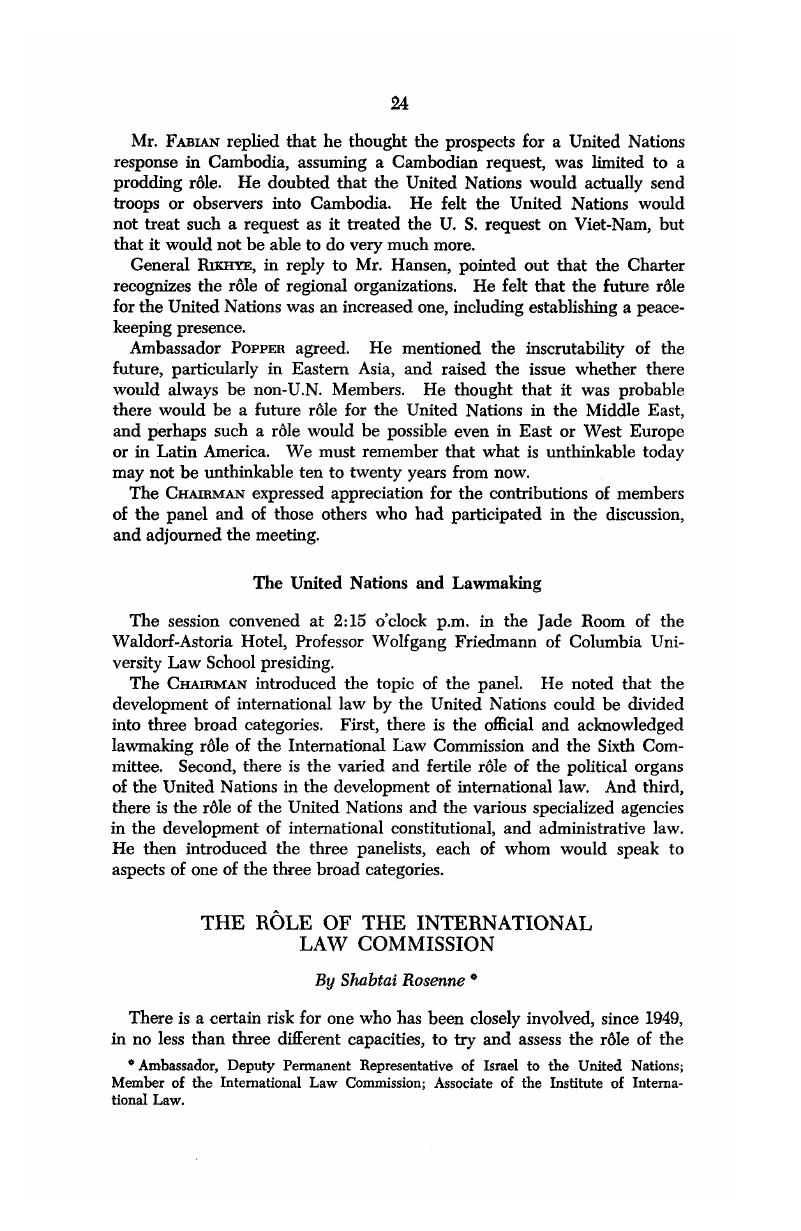No CrossRef data available.
Article contents
The Rôle of the International Law Commission
Published online by Cambridge University Press: 28 March 2017
Abstract

- Type
- Panel: The United Nations and Lawmaking
- Information
- Copyright
- Copyright © American Society of International Law 1970
References
1 See, above all, Briggs, The International Law Commission (1965).
2 In the meetings of the Committee on the Progressive Development of International Law and its Codification (the Committee of Seventeen), U.N. Doc. A/AC.10/SR.4, p. 3. For an assessment of Amado’s rôle in the codification of international law, see the tributes paid to his memory in the Sixth Committee in 1969, U.N. Doc. A/C.6/L.791, March 25, 1970 (mimeographed only), and at the 1046th meeting of the International Law Commission, May 11, 1970.
3 Cf. the statement of the Chairman of the International Law Commission at its 17th Session, Milan Bartoš, at the 839th meeting of the Sixth Committee on Sept. 29, 1965. U.N. General Assembly, 20th Sess., Official Records, Sixth Committee at 6 (1965).
4 South West Africa cases (Ethiopia v. South Africa; Liberia v. South Africa), Preliminary Objections, Judgment of Dec. 21, 1962; [1962] I.C.J. Rep. 319 at 346.
As an illustration, note that the Hague Conference of 1930 in principle met in private—something that would be unthinkable today. Acts of the Conference for the Codification of International Law (Official No. C.351.M.145.1930.V), Vol. I, p. 20; Vol. 2, p. 15; Vol. 4, p. 17. Rub XI of the Rules of Procedure provided that the minutes of meetings of committees should not be published until after the close of the Conference which itself had the power to defer publication of certain minutes as an exceptional measure. In the United Nations Codification Conferences, normally only the Drafting Committees and ad hoc working groups meet in private.
5 See the discussions at the 879th and 880th meetings of the International Law Commission in 1966. [1966] I.L.C. Yearbook (I) 240.
6 I.L.C. Report, General Assembly, 4th Sess., Official Records, Supp. 10, U.N. Doc. A/925 (1949), at 3. Topics numbered 5, 6, 7, 10, 11, 12 and 14 have been completed in the Commission.
7 Review of the Commission’s Programme of Work and of Topics recommended or suggested for Inclusion in the Programme, to be published in [1970] I.L.C. Yearbook (II), U.N. Doc. A/CN.4/230.
8 I.L.C. Report, U.N. General Assembly, 23rd Sess., Official Records, Supp. 9, U.N. Doc. A/7209/Rev.1, at 32.
9 I.L.C. Report, U.N. General Assembly, 24th Sess., Official Records, Supp. 10, U.N. Doc. A/7610/Rev. 1, at 32. The document cited in note 7 above was prepared in response to that decision.
10 U.N. General Assembly Res. 2501 (XXIV), Nov. 12, 1969.
11 [1963] I.L.C. Yearbook (II) 227, U.N. Doc. A/CN.4/152 (1963).
12 To be published in [1969] I.L.C. Yearbook (II), U.N. Doe. A/CN.4/217 (1969).
13 Loc. cit. in note 6, at 1.
14 I.L.C. Report, U.N. General Assembly, 13th Sess., Official Records, Supp. 9, U.N. Doc. A/3859, at 30. And see General Assembly Res. 1290 (XIII), Dec. 5, 1958.
15 See discussion at 972nd meeting of the Commission on July 10, 1968. [1968] I.L.C. Yearbook (I) 169.
16 General Assembly Res. 685 (VII), Dec. 5, 1952.


